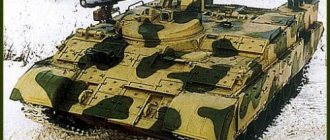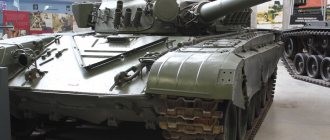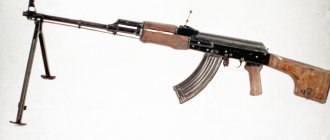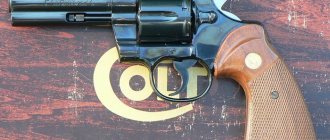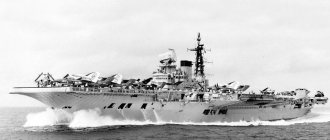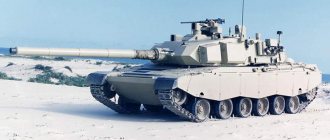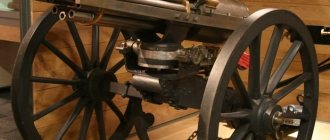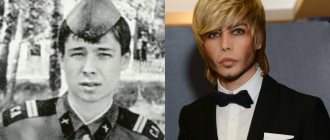Players who choose an anti-tank self-propelled gun are rarely unhappy in the sandbox. Among tanks of the first, second and even third tier, the starting “petashki” stand out favorably with firepower and the ability to penetrate any armor. Yes, you have to pay with slowness and the lack of a tower, but this is taken for granted.
But at the next level everything changes. The player begins to be thrown towards the “big guys” driving around in “thirty-fours” or KVs, which are virtually invulnerable to fire from third-level tank destroyers. In addition, serious artillery appears, for which the sedentary “petashka” is an ideal target. At this point, many novice players become disillusioned with anti-tank guns.
However, it is not at all useless, but simply requires special thinking and tactics that allow you to fully realize all its advantages and neutralize the disadvantages. So how can you turn a tank destroyer into a truly dangerous vehicle?
Let's start with the fact that tank destroyers are inferior to tanks in a direct collision. Of course, in a “fair” fight, a “petashka” can cope with a tank of its level from a standing position (a lot depends on the specific vehicles here). But, alas, tank owners also know this and therefore are in no hurry to engage in a fair firefight, preferring cunning. For example, taking advantage of your mobility, go to the flank or rear and calmly fire at the car, cutting circles around it.
The tank destroyer does not have a turret and cannot fire and maneuver at the same time. To catch the enemy in sight, the “petashka” needs to turn around with its entire body. However, the enemy also does not stand still, moving along the line of rotation of the vehicle in order to be out of reach of its gun. And at the same time it conducts continuous shelling of the sides and stern. I don’t even want to talk about what will happen if we manage to shoot down a caterpillar from a tank destroyer. Thus, you can lose your “pet” even when meeting with a relatively weak tank, without firing a single serious shot at it.
Therefore, our task is to fight from afar, keeping enemy vehicles away and supporting our tanks with fire. Moreover, one of the main advantages of the class is a very accurate direct shot. But even here, not everything is so simple, because the sedentary and painfully stinging “pet” becomes very vulnerable if it is discovered.
► A very accurate straight shot is one of the main advantages of the class.
Only the most serious self-propelled guns have armor capable of withstanding a hit from a 76-mm projectile or higher, while early tank destroyers are weakly armored, and one or two hits will be enough to kill them.
The most important conclusion follows from this: the main thing for an anti-tank installation is choosing the right position and camouflage.
Skillful camouflage is generally a very important thing in the game, but for tank destroyers it is the main trump card of the class and the key to understanding the correct tactics for these vehicles. A properly camouflaged SU-85 will easily destroy an early heavy tank (KV or T1), but, once detected, it will not withstand even a few seconds of direct combat. The ideal situation for us is to fire at an enemy who does not see the tank destroyer attacking him and cannot respond, or to direct artillery fire at the anti-tank installation’s position.
The most impressive and enjoyable experience when playing this class is when a pair of pets, completely invisible to the enemy, stop the attack of superior enemy forces, knocking out a couple of tanks with impunity and forcing the survivors to retreat in front of an unknown and therefore even more terrible enemy.
To achieve this effect, you need to have a good understanding of how the camouflage system works in World of Tanks.
In addition to such basic indicators as armor thickness and engine power, all vehicles have the “View Radius”
. It determines the distance from which the tank can detect an enemy vehicle. If the viewing radius is 400 meters, then at 401 meters the enemy tank is simply invisible to the player. The maximum possible viewing radius is 500 meters.
Everything seems simple. In addition, the game has light “firefly scouts”! Thanks to them, heavy vehicles fight at distances exceeding their viewing radius. In reality, everything is much more complicated, because there are many factors that reduce the visibility of a tank.
First of all, the dimensions of the machine itself. As you might guess, a light tank is less noticeable than a heavy one, and a tall vehicle is more noticeable than a low one. Thus, low-profile and light tank destroyers are less noticeable than tanks of similar levels, and, given their low survivability, they simply must take advantage of this.
The second factor is the relief and landscape of the area. With the terrain, everything is obvious - behind a hill blocking your line of sight, your car is not visible to the enemy, but you cannot see him either. With landscape elements it’s a little more difficult. The walls of houses act, in principle, in the same way - blocking both lines of sight and shots (just keep in mind that small village houses are destructible and will not serve as shelter from fire for long). But all sorts of bushes partially block visibility, making the tank hidden in them much less noticeable.
Therefore, in order to detect a hidden car, you need to drive closer. At the same time, she sees the approaching tank absolutely clearly, since up close (from fifteen meters to be precise) the bushes are considered absolutely transparent - the so-called “curtain effect” operates. Thus, a camouflaged vehicle receives serious advantages, since it can fire at an approaching target for some time with impunity.
► Thickets in front, thickets on the right - from the enemy’s side I’m almost invisible.
IT IS IMPORTANT:
from fifty meters, tanks can see each other in any case, even if there is an impenetrable obstacle between them.
Please note that a shot or movement unmasks it, increasing the visibility of the hidden vehicle for a few seconds. The larger the caliber of the gun, the stronger the unmasking effect. But, despite this, an inconspicuous tank destroyer, camouflaged at the very edge of the viewing radius of a heavy tank or hidden in dense thickets (the effect of reducing visibility is stronger, the more bushes there are between the vehicles), can fire from a powerful gun while remaining completely invisible.
Disguise rules
| ► An example of incorrect masking. The hull of the tank destroyer protrudes from the thickets, and the enemy can see it. | ► An example of proper camouflage. Detecting tank destroyers from this side will not be easy. |
To disguise yourself, just stand behind bushes that completely hide the outline of the tank from the side where the enemy is expected to appear.
To check the thoroughness of your disguise, you can hold down the right mouse button and rotate the camera so as to inspect the tank from the side where the enemy is expected to appear. A gun sticking out of a bush does not unmask a tank, but a part of the hull or turret protruding from behind a bush reduces the camouflage to nothing. You also need to always remember that an enemy scout approaching from an unmasked side will easily detect you and transmit the data to his team. If you are sure that you were discovered, albeit for a short time, change your position; the enemy can fire at the “exposed” position from memory. Also remember: particularly skilled artillerymen can calculate your position using the shell tracer (this is easier to do the larger the caliber of your gun). Therefore, changing position after a series of shots is not harmful in any case. First of all, the tank destroyer is a support combat vehicle, its task is to remain in the shadows and support defense and attack with fire from a position. The choice of position is the most important part of tactics, determining the success of the “petashka” in battle. The best position combines three advantages: first, the terrain from it is covered in a straight line as far as possible and in the widest possible radius, second, there is room for good camouflage, and third, there is a heavy tank in front of it.
“Petashka” can, of course, fight something on her own, but she works best in a team, where her task is to maximize the density of fire. If a pair of equal tanks clash in front, as a rule, the one who is better supported by fire will win, so your task is not to yawn and shoot well.
To make shooting effective, study the characteristics of future targets and your gun. If you know that this tank cannot be penetrated by an armor-piercing shell from your gun either in the forehead or on the side, “turn off” the easier target first. If this is not observed, and there is no stock of premium shells for a rainy day, try firing at the armored monster with high-explosive fragmentation shells (always carry 10-15 with you). They will not be able to penetrate anything that cannot be penetrated by armor-piercing weapons, but a strong explosion on armor is an unpleasant thing. After all, it can damage some of the external systems of the tank, or even concuss one of the crew, which will greatly facilitate the “work” on the target for those who can penetrate the armor.
ON A NOTE:
the effect of a high explosive charge depends on its caliber.
If a heavily penetrated tank is moving towards your position, you will have to open fire in any case, but if it bypasses it, take your time to shoot and assess the situation. If it turns out that it was you who “exposed” an impenetrable monster for your team, perhaps it is better not to give away your presence and work for a while as an artillery fire spotter. If an invulnerable enemy notices you, it is better not to be a hero in a obviously lost battle, but to try to hide behind a building or in the folds of the terrain. This way you can, occasionally leaning out of there, transmit to your team data on the position of the enemy super-heavy tank, which will annoy him much more than your dying mosquito bite.
Do not rely on auto-aim (for tank destroyers it is almost always rather harmful). If you are firing at an armored vehicle, give preference to weakly protected planes and direct or close angles of impact. If the tank begins to turn, hold the shot until the moment when it puts its side or stern at a favorable angle. If at this moment your gun is reloading after a shot ricocheted by the frontal plate, it will be a shame. A well-placed hit can knock down even the heaviest enemy's tracks, making them an easy target for your artillery and other teammates.
► I hit the caterpillar - now it’s time to quickly retreat behind this house!
When attacking, move at a distance behind your vehicles, “running” from one good position to another. However, if the situation dictates a rush attack, just tag along with some well-armored vehicle. She will take the damage - you will support her with fire. However, if you ride a heavy tank destroyer, such as the Ferdinand, you yourself can serve as a steel wall for lighter vehicles.
When choosing equipment, always choose a cannon with a b o
A gun with greater armor-piercing power will do
more
damage. After all, your task is to hit heavy, not lightly protected targets (medium tanks can handle this too). At the first opportunity, buy a camouflage net - a “peteshka” in an ambush will absolutely need it. Considering that the artillery loves us, we also buy anti-fragmentation lining.
As for equipment, I recommend taking with you a standard repair kit and a first aid kit; for Soviet tank destroyers, a tightened engine speed controller is also suitable. Although this thing damages the engine, it is absolutely irreplaceable if you still have to fight a light or medium tank that has broken into close combat.
There are no revelations regarding the development of the tank destroyer crew; the very specifics of the class dictate the only answer: the “camouflage” skill is our everything.
ON A NOTE:
the “camouflage” skill reduces the visibility of a tank, even if it is moving.
Although tank destroyers were an important part of American military doctrine, American vehicles of this class are not yet in the game. Let's take a brief look at sixteen Soviet and German "peteshki" that are now available for players to choose from.
AT-1 and PanzerJager 1
Soviet and German tank destroyers have a number of serious differences, but these two vehicles can be considered in pairs without fear of missing anything. Early "petashki" stand out against the background of the "sandbox" with impressive fire characteristics. The AT-1, however, looks more impressive; the guns of this vehicle easily destroy tanks of the first and second levels, so skilled tankers can score 8-9 “frgs” on this tank destroyer.
PanzerJager1, although more maneuverable, cannot boast of similar results. However, already at the next level the German tank destroyers will win back.
PT USSR
It is worth noting right away that all Soviet tanks are distinguished by the absence of a turret, which makes the gameplay on them specific and not as comfortable as on TT or ST. Therefore, it is better not to upgrade them first, but to master turret tanks first. Soviet tanks start with one vehicle of the fifth level and after the sixth level they diverge into two branches leading to two tops of the 10th level.
3.1. Branch Ob.268
This is an older branch of classic Soviet tank tanks, characterized by high one-time damage, but mediocre armor.
SU-85 (tier 5)
From the very beginning, Soviet PTs reveal the whole essence of the branch and teach you how to play this class of equipment correctly. These are moderately mobile vehicles with a fairly high alpha and penetration for their level. They have sloping armor on the front, which sometimes saves them from being penetrated by classmates and vehicles of a lower level. They feel best when playing from a medium distance, since from a long distance it is difficult to hit the enemy due to the oblique weapon, and in close combat they are very vulnerable due to weak armor and the lack of a turret. The SU-85 is no exception, it’s a pleasure to shoot damage from a hill from behind the bushes, you’ll often deal a lot of damage, and that’s a joy. This is facilitated by a relatively low silhouette and good basic camouflage indicators (compared to larger tank vehicles and vehicles of other classes). If there is no position on the map suitable for shooting, then simply stay on the second line, following your allies and helping them with fire, trying not to expose yourself. But this PT is completely blind (the field of view is only 280 m), even with a pipe it will be only 350 m, which is far from normal indicators and you won’t be able to illuminate yourself. So it’s better to upgrade the crew’s camouflage, install a network or MSV, and the rest of the equipment for firepower (rammer + UMP). In general, this is far from a cactus, but decide for yourself whether to leave it in the hangar; personally, I prefer a tank with a higher alpha.
SU- 100 (level 6)
It differs from its predecessor mainly in the presence of a top-end 122 mm “club” with huge one-time damage for its level (390 units) with good penetration (175 mm) and sufficient DPM for such an alpha (1900 units). This is a very formidable machine, capable of brutally annihilating a not very nimble enemy. The camouflage indicators are similar to the previous vehicle, and the visibility is higher (350 m) and, if desired, a pipe can be installed here (for those who do not want to rely on allies and be able to shine for themselves). But you will have to move away from the bites before the shot or roll back after, since fire from a large-caliber gun will greatly unmask you. The car should be left in the hangar.
SU-152 (level 7)
Here everything becomes somewhat sadder - with an increased level we have the same weapon with an alpha of 390 and a penetration of 175 mm. True, it converges and shoots faster, the DPM is quite decent (3300 without equipment). In principle, this is not bad for a seven, but it is worth taking into account weak armor, lower camouflage and visibility (only 330 m). This PT also does not have good mobility. The recommendations are the same - support your allies from a medium distance and try not to expose yourself, since HP is very low (870 in total). The car feels best when playing with classmates and lightly armored eights; with stronger opponents it will be a little difficult, you will have to shoot gold from a distance. Well, the stock 152mm high explosive has lost its relevance after the nerf of HE shells. The car is unremarkable and rather weak for its level, as it gets into battles with eights and nines, which are difficult for it to resist.
ISU-152 (level 8)
Another large, slow “trough” with an oblique, long-retracting gun, poor armor and mobility. However, at the top we have a tenth level gun with an alpha of 750 and penetration of 260 mm, with a completely normal DPM (more than 2600), which can hurt almost any enemy. But, despite the increased number of strength points (1200 HP), they are still not enough for your level, so you need to play carefully from a medium distance with the ability to quickly roll into cover (hide behind the terrain). The camouflage is rather weak, the visibility is 350 m and it is hardly worth upgrading, since such a “barn” at the eighth level will be overexposed by anyone. In general, this PT, to put it mildly, does not inspire delight in the game; the next car is much more pleasant in every way. So I don’t see any point in leaving it in the hangar, if only I had the nerves to get through it...
Vol.704 (level 9)
Perhaps one of the best cars in the branch, on par with the SU-100 at its sixth level. The “leftover” has everything you need for bending - a powerful weapon with a decent alpha (750 units), penetration (286 units) and DPM (more than 2700), some kind of frontal armor with a good slope, from which even shells sometimes ricochet ten and a minimum of strength for survival (1600 HP). At the same time, the vehicle is much more mobile than its sluggish and clumsy predecessor, and the gun is brought down noticeably faster. The object is a real PT, which was once the thunderstorm of the entire random, has still not lost its relevance and is a pleasure to ride. The disadvantages include a low level of camouflage and a visibility of 360 m; the vehicle also requires thoughtful play from a medium distance. The AT is worth leaving in the hangar not only because of its historicity.
Vol.268 (level 10)
In all respects, an improved version of the object - the weapon is pleasant, it is aimed even faster, it hits more accurately, the DPM is slightly higher, the durability is also excellent, and the mobility is excellent. But, despite the armor and its slope, it easily breaks through at its level. It requires careful play from a distance, having low camouflage and a field of view of 370 m. Among the unpleasant shortcomings, it is also worth noting that the downward angle of the gun was reduced from -6 to -5, which makes it more difficult to play off the terrain and quickly hide the hull, rolling back, so how to roll out further. In general, the car is weaker than its predecessor at its level, it only gets into tough battles with dozens and is more expensive to repair. So, in my opinion, in this branch it is better to stop at nine, and for the sake of ten go along an alternative branch.
3.2. Branch Ob.268/4
This is a newer branch, which starts at level 7 and is distinguished by its specifics, namely, more accurate and faster-firing guns, a strong rear-mounted wheelhouse and good mobility. All cars have both their pros and cons.
SU-100M1 (level 7)
According to alpha, we immediately roll back (from 390 to 250 units), but the penetration is quite high for its level (212 versus 175 mm), which will make it easier to implement DPM (2200 units). In addition, there is a very strong cabin, which will be too tough for even machines of a higher level. VLD also has armor sufficient to protect against most of his classmates, but NLD, as usual, is weak. There is camouflage (at level 6), visibility is 350 m. However, the rear location of the cabin and poor downward air pressure (only -4 degrees) do not allow you to play off the terrain. All this dictates a certain type of gameplay - playing on a flat surface from various distances from the cabin, hiding a low NLD behind cover (a hillock, an embankment). It will be quite difficult to penetrate you into the wheelhouse, and you will be able to inflict damage on opponents with almost impunity, which is nice. True, there is an exception to this rule - eights on gold and nines that can break through you. So don’t be a hero in high-level battles; you can brazenly crush the enemy only at the top. I don’t see much point in leaving this AT in the hangar due to the small one-time damage of the gun; it is not always possible to implement the DPM.
SU-101 (level 8)
A very similar vehicle, but with an “adult” level 10 gun (alpha 440, penetration 258 – excellent performance for an eight). The camouflage indicators are similar, but a shot from a gun greatly reveals the visibility of 350 m. The main drawback is the disgusting air level (only -3 degrees down), which will cause problems even from small tubercles (the gun will ride up and you will not be able to aim at the enemy). But in skillful hands, having hidden the NLD, the vehicle can significantly help the allies maintain or push the direction. However, be careful - the relatively small DPM (about 2200) and the amount of HP (1100 units) will not allow you to survive for a long time in a shootout with a strong enemy on gold, keep some distance and do not stand under heavy fire. In general, you can bend this PT, if it suits your style of play, you can realize its strengths (strong cutting) and level out its weaknesses (bad air-trapping), you can leave it in the hangar.
Vol.263 (level 9)
This vehicle repeats the concept of the previous one - a well-balanced gun, a strong, practically impenetrable wheelhouse and VLD, but poor downward deflection of the gun. Plus (or rather a huge minus) there is a very weak large NLD at a bad angle, which is more difficult to hide and can easily be penetrated even by tanks to the level below. In general, if not for this drawback, this tank could be considered one of the most powerful in close combat. She has enough HP (1800 units) that can be exchanged, but due to the small DPM (2250 units), it is better to do this from the alpha with opponents who do not have high one-time damage. If you thoroughly study the positions where you can hide the NLD and effectively shoot damage, you could leave the car. But personally, I wouldn’t, as this greatly limits the possibilities of application on different maps. It makes sense to go through nine mainly for the sake of an excellent level ten PT.
Ob.268/4 (level 10)
The most powerful assault tank in the game, on which you can and should aggressively push directions. This is a real nightmare for those whom she meets along the way. The weapon here, by modern standards, is quite ordinary with normal one-time damage (650 units), but not very high DPM (2400 units). But the frontal armor is simply outstanding, this applies not only to cutting and VLD, but also to NLD, which only dozens can penetrate at right angles, and with a slight twist, not every gold will take it. Thanks to this, the vehicle’s survivability in battle is very high; it must always be at the forefront of the advancing allied forces. But skill players will still be able to hit you with gold in the NLD and a small commander’s hatch (horns) on the wheelhouse, so you shouldn’t hit it directly with your forehead, you need to move and “move” all the time, so you will be almost invulnerable. If aggressive play is not your thing, pass by, don’t expose your allies, you still won’t shoot anything while standing on a hill or in the bushes at the base. For these purposes, there are much more suitable vehicles with good camouflage and accurate damage weapons such as German anti-tank guns with a rotating turret, which are perfect for careful play from a distance.
Marder II
It is no different from the SU-76 in terms of armor and almost no different in survivability (170 versus 150 for the Soviet vehicle), weight and engine power. It would seem that in front of us is the same weak tank destroyer, doomed to sad vegetation while waiting for the next vehicle. However, a couple of important differences turn the Marder II into a truly dangerous “petashka”, in comparison with which the SU-76 looks like a poor relative.
Firstly, an amazing viewing radius of 460 meters (the largest among all tank destroyers in the game!), and secondly, very large horizontal guidance angles (the SU-76, like all Soviet vehicles, is aimed only in a very narrow cone) and excellent late guns. Firing a KV from an SU-76 is not a hopeless matter, but it’s close to it. Marder II penetrates HF at any point.
From “Acacia” to “Coalition”: modern heavy self-propelled guns
From “Acacia” to “Coalition”: modern heavy self-propelled guns
19 November '15
On November 19, the armed forces of Russia and Belarus celebrate the Day of Missile Forces and Artillery. For the professional holiday of artillerymen and rocketeers, Warspot has prepared a review of heavy tracked self-propelled guns of the second half of the 20th – early 21st centuries with a caliber of more than 152 mm.
Tracked self-propelled artillery systems continue to dominate in the 21st century, forming the basis of the mobile artillery fleet in many countries around the world. Wheeled self-propelled guns, despite the emergence of new interesting models, remain a niche weapon, the use of which is significantly limited by terrain conditions.
The evolution of tracked self-propelled guns over the course of about a century of history had common features with the development of tanks, which is not surprising - many self-propelled guns had and still have tank chassis as a base. The caliber of guns gradually grew, the combat weight of installations increased - but, as in the case of tanks, this trend persisted only to a certain point. In the case of tanks, the development of gigantism stopped as a result of the emergence of a “compromise” class of main tank, and for tracked self-propelled artillery units, the caliber of 152–155 mm became the limit.
If in the 50-70s self-propelled guns with guns with a caliber of up to 200 mm or more were created and put into service, today new self-propelled guns practically do not cross the threshold of 155 mm. A large caliber was considered by designers as a way to increase the firing range. But scientific and technological progress (for example, the creation of active rockets) made it possible to achieve a projectile flight range of up to 70 km without creating gigantic artillery systems. In addition, the niche of ultra-long-range artillery has been occupied to some extent by tactical and operational missiles.
If the background of the photos interferes with reading the signatures, you can hover your mouse cursor over the text - this will darken the background of the signature.
M44, USA. 155 mm howitzer, produced since 1954. The photo shows an M44 during exercises in West Germany, 1960. Crew 5 people. Weight 31 tons, engine power 500 hp, maximum speed 56 km/h. Ammunition 24 rounds, rate of fire 1 round per minute, firing range 14.6 km. About 600 M44 built militarymashup.com
M110, USA. 203 mm howitzer, produced since 1962. Crew 5 people. Weight 28.3 tons, engine power 450 hp, maximum speed 55 km/h. Ammunition 2 shells, firing range 16.8 km. More than 1,000 M44s were built. They continue to be in service in Greece, Iran, South Korea, Turkey, Japan, Taiwan and other countries pinterest.com
M-50 155mm, Israel. 155 mm howitzer, developed in the early 1960s. based on the Sherman tank. Calculation of 8 people. Weight 47 tons, engine power 460 hp. Ammunition capacity: 47 shells. About 120 machines were created
L-33/Ro'em, Israel, 155 mm howitzer. Another self-propelled gun based on the Sherman; probably around 200 units produced
M107, USA. 175 mm howitzer, produced since 1962. Photo shows an M107 firing during Operation San Angelo, Vietnam, 1968. Crew 5 people. Weight 28.3 tons, engine power 450 hp, speed up to 55 km/h. Ammunition capacity: 2 shells, firing range up to 32.7 km. They are in service in Israel, Iran, Turkey and Vietnam militarymashup.com
M109, USA. 155 mm howitzer, produced since 1962. The photo shows an Egyptian M109 during the Operation Bright Star exercise on September 15, 2005. Crew 6 people. Weight 23.8 tons, engine power 450 hp, speed up to 61 km/h. Ammunition capacity of 28 shells, rate of fire up to 6 rounds/min, firing range up to 22 km. Standard NATO self-propelled gun
Bandkanon 1, Sweden. 155 mm howitzer, in service since 1967. Crew 5 people. Weight 52 tons, engine power 240+290 in modification A (300+290 in modification C) hp, maximum speed 28 km/h. Transportable ammunition: 14 rounds, rate of fire up to 15 (one in the barrel) rounds in 45 seconds tv.nrk.no
2S3 "Akatsia", USSR. 152 mm howitzer, in service since 1971. Crew 4 people. Weight 27.5 tons, engine power 520 l/s, speed up to 60 km/h. Ammunition capacity of 40–46 rounds, rate of fire up to 3.5 rounds/min, firing range up to 25 km. About 4,000 2S3s were built. It is in service in approximately two dozen countries gvtm.ru
Type 75, Japan. 155 mm howitzer, adopted for service in 1975. Crew 6 people. Weight 25.3 tons, engine power 450 hp, maximum speed 47 km/h. Ammunition 28 rounds, rate of fire 6 rounds/min, firing range up to 19 km. 201 units built
2S7 "Pion", USSR. 203 mm gun, produced since 1975. The photo shows an Azerbaijani self-propelled gun 2S7 in Baku. Crew 7 people. Weight 45 tons, engine power 780 hp, maximum speed 50 km/h. Ammunition 4 shells, firing range 50 km. More than 500 self-propelled guns were built. Available in the armies of Azerbaijan, Angola, Belarus, Georgia, Russia, Uzbekistan, Ukraine
2S5 "Gyacinth-S", USSR. 152 mm gun, produced since 1976. The photo shows a Belarusian self-propelled gun 2S5 at a parade in Minsk. Crew 5 people. Weight 27.5 tons, engine power 520 hp, speed up to 63 km/h. Ammunition capacity of 30 rounds, firing range up to 33 km. More than 2,000 2S5 self-propelled guns were built. Used in Belarus, Russia, Uzbekistan, Ukraine, Finland
AMX AuF1, France. 155 mm howitzer, produced since 1977. The photo shows a Saudi AuF1 with its crew. Crew 4 people. Weight 46 tons, engine power 720 hp, maximum speed 60 km/h. Ammunition 42 rounds, firing range 30 km, rate of fire 8 rounds/min. Operated in Kuwait, Iraq, Saudi Arabia and France
M1978 "Koksan", North Korea. 170 mm gun, in service since 1978. Calculation of 8 people. Weight 46 tons, speed up to 40 km/h. It does not carry ammunition, the rate of fire is 1–2 rounds per 5 minutes, the firing range is up to 40–60 km. Delivered to Iran and Iraq modelsuwemilitaria.blogspot.com.by
Palmaria, Italy. 155 mm howitzer, produced since 1982. The photo shows Libyan Palmaria self-propelled guns near Ajdabiya in 2011. Crew 5 people. Weight 46 tons, engine power 750 hp, speed up to 60 km/h. Ammunition 30 rounds, firing range up to 30 km, rate of fire 4 rounds/min. 235 vehicles were built and delivered to Libya and Nigeria; towers - to Argentina
2S19 "Msta-S", USSR. 152 mm howitzer, in service since 1989. Crew 5 people. Weight 42 tons, engine power 780–840 hp, speed up to 60 km/h. Ammunition 50 rounds, firing range up to 29 km, rate of fire 7–10 rounds/min. More than 720 vehicles were built. They are in service in Russia, Azerbaijan, Belarus, Venezuela, Ukraine, Ethiopia
M109A6 Paladin, USA. 155-mm howitzer, modification of the M109 with a new turret, radio station and fire control system, adopted for service in the United States in 1992. Crew 5 people. Weight 32 tons. Ammunition 39 rounds, firing range up to 30 km, rate of fire up to 4 rounds/min. About 1200 self-propelled guns were produced. In service in the United States and Saudi Arabia afcent.af.mil
AS-90, UK. 155 mm howitzer, produced since 1992. Crew 5 people. Weight 45 tons, engine power 660 hp, maximum speed 53 km/h. Ammunition 48 rounds, firing range up to 40 km. 179 vehicles were built. In service in the UK
PLZ-45, China. 155 mm howitzer, in service since 1997. The photo shows a PLZ-45 of the Kuwait Army. Crew 5 people. Weight 43 tons, engine 520 hp, speed up to 55 km/h. Ammunition 30 rounds, firing range up to 39 km, rate of fire 4–5 rounds/min. In service in China, also supplied to Algeria, Bangladesh, Kuwait and Saudi Arabia
K9 Thunder, South Korea. 155 mm howitzer, produced since 1999. Crew 5 people. Weight 47 tons, engine power 1000 hp, speed up to 67 km/h. Ammunition 48 rounds, firing range up to 40 km, rate of fire 6–8 rounds/min. 1140 units produced; Licensed production has been established in Turkey (about 180 vehicles have been produced) krigeren.dk
PzH 2000, Germany. 155 mm howitzer, produced since 1998. Calculation of 5 people. Weight 55 tons, engine power 986 hp, maximum speed 60 km/h. Ammunition capacity 60 rounds, firing range up to 40 km (a world record of 56 km was set), rate of fire 8–10 rounds/min. More than 300 pieces produced; is in service in Germany, Greece, Italy and the Netherlands
Type 99, Japan. 155 mm howitzer, produced since 1999. Crew 4 people. Weight 40 tons, engine power 600 hp, maximum speed 60 km/h. Ammunition 30 rounds, firing range up to 38 km, rate of fire up to 6 rounds/min. 111 units produced; is in service in Japan ddmurasame.deviantart.com
SSPH Primus, Singapore. 155 mm howitzer, in service since 2004. Crew 4 people. Weight 28.3 tons, engine power 550 hp, maximum speed 50 km/h. Ammunition 26 rounds, firing range up to 30 km, rate of fire up to 6 rounds/min. 48 self-propelled guns were built; is in service in Singapore
PLZ-05, China. 155 mm howitzer, produced since 2007. Crew 5 people. Weight 35 tons, engine power 520 hp, maximum speed 55 km/h. Ammunition 30 rounds, firing range up to 52 km, rate of fire up to 8 rounds/min. About 276 built. In service in China
AHS Krab, Poland. A 155-mm howitzer with a turret from the British AS-90 and a chassis based on Polish-made T-72 components (pictured). Produced since 2008. Crew 5 people. Weight 52.1 tons, engine power 850 hp, speed up to 60 km/h. Ammunition 26 rounds, firing range up to 40 km, rate of fire up to 6 rounds/min. 10 self-propelled guns built
2S35 "Coalition-SV", Russia. 152 mm howitzer, produced since 2013. Crew 3 people. Weight up to 48 tons, engine power 1000 l/s. Ammunition capacity is 50–70 rounds, the stated firing range is up to 70 km and the rate of fire is up to 16 rounds/min. 12 vehicles were built. Self-propelled guns were officially demonstrated for the first time on May 9, 2015
Hetzer
The transition to the fourth level tank destroyer quickly cools the ardor of the “German” armor-piercers. The Hetzer is inferior to the previous vehicle in everything except armor. It is slow moving, has a short viewing radius (300 meters), and the best of its guns is slightly inferior to the “top” gun of the Marder II. And then there are the strange pointing angles (the gun almost doesn’t turn to the right) - and we have before us one of the most unloved tank destroyers by players.
Very small dimensions and 60 mm frontal armor (giving good chances against light and early medium tanks) do not help this vehicle to rehabilitate itself. Many players prefer to install a 105mm gun on the Jaeger and shoot exclusively with high-explosive fragmentation weapons. At the very least, this method is guaranteed to damage your enemies' health.
T-95 (tank destroyer): history of use
By the end of the war, two combat vehicles were produced in Europe and on the Pacific front. They had two pairs of tracks, which significantly increased their width, and an engine with a capacity of 500 horsepower. This, however, was very little for moving a super-heavy installation. Such an engine was also installed on the Pershing tank, but it was two times lighter than the Turtle. By the way, the T-95 was awarded this name. The tank destroyer was a model whose maximum speed was only 12-13 km/h.
Thus, this armored self-propelled gun was practically “standing”, which did not suit the army leadership, since the self-propelled guns had to be delivered to the required point only by rail. But not all was well here either. Due to the second pair of tracks, the width of the self-propelled gun was greater than that of railway platforms. In order to somehow accommodate the T-95, additional tracks had to be removed, which took at least four hours.
SU-85 and SU-100
A player developing a line of Soviet tank destroyers is waiting for the opportunity to switch to the SU-85, like a New Year's child. After the flimsy SU-85b, this car looks impressive. Its armor allows it not to be afraid of light tanks, and the gun penetrates the first IS and the Tiger into the side. This comes at the cost of less mobility. Yes, and you can’t enjoy the increased characteristics - after all, she is thrown to even more serious opponents, and when not “Stuarts” and A-20s, but “Panthers” come to “shine” from the enemy side... However, a player who has already eaten the dog at the organization ambush, will know what to do about it.
The SU-100 is essentially the same SU-85, only with improved armor and impressive guns. The 100-millimeter D-10s cannon, which gives the vehicle its name, has a chance to penetrate the forehead with a standard IS-4 armor-piercing projectile, and a high-explosive fragmentation projectile fired from such a cannon removes about 5% of the life of a super-heavy tank. Well, the 122-mm gun, which has the same armor-piercing power but with increased damage, demonstrates even more impressive results.
Weaknesses of "Turtle"
In addition to the fact that this tank had significant shortcomings, the self-propelled gun, despite its powerful armor, was also easily vulnerable, as technical sea trials showed. The T-95 (tank destroyer) had the following penetration zones.
The most vulnerable point of this tank destroyer is its chassis. A few hits on the tracks - and the self-propelled gun stops in place, and then do what you want with it. It does not have a gun turret and cannot deploy the cannon. The self-propelled guns also have no additional weapons, except for the commander’s Browning machine gun.
Also the weak point is the side armor, the thickness of which does not exceed 65 mm. The fast, maneuverable tanks and self-propelled guns of World War II could quickly outflank and rear the T-95 and cause serious damage, leading to the death of the crew.
Another weak point of this self-propelled gun was the commander's hatch, which did not have sufficiently powerful armor.
And the last minus of “Turtle”. After the war, it became clear that the power of the gun and armor did not decide the outcome of the battle. The emphasis was not on super-heavy military equipment, but on mobile and compact ones, which could quickly change their location, strike the enemy and just as quickly retreat back. But just to load a tank destroyer onto a railway platform, it was necessary to spend about four hours, which, under the conditions of modern wars, is simply an unaffordable luxury. Such equipment can be destroyed even at the loading stage.
StuG III, JagdPz IV and JagdPanther
These vehicles are very similar to the SU-85 and SU-100, only better armored in the front, worse on the sides and somewhat more mobile, which makes them more convenient in the offensive.
The ability to destroy enemy tanks increases from vehicle to vehicle. Thus, the StuG III can penetrate the side of a Tiger, and the “top” JagdPanther cannon threatens anyone with
tank in the game.
It is worth noting the very low profile of the StuG III and JagdPz IV, thanks to which these vehicles are easy to camouflage.
SU-152 and ISU-152
If we compare these heavy tank destroyers with super-heavy tanks, their armor is not very serious (90 millimeters of frontal armor for the ISU-152). But the “petashki” have amazing firepower. For example, with a little luck, one shot is enough to destroy a medium tank. In addition, no heavy tank would be safe near them. Armor sufficient to fight medium tanks allows them to act autonomously, but still the cover of heavy tanks greatly simplifies the game.
History of the production of "Turtle"
In late 1943, the United States began a program to develop heavy armored vehicles. The Americans were prompted to do this by global studies of the military situation on the Western Front, which showed that Allied troops may need a heavy combat vehicle capable of breaking through complex enemy defenses.
The developers took the base of the T-23 medium tank and the electronic transmission of the heavy T1E1 as the basis for the future T-95 tank destroyer. Armored plates 200 mm thick and a new 105 mm gun were installed on this base. This weapon could penetrate and destroy almost any concrete structure.
It was planned to produce 25 such vehicles within a year, but the command of the ground forces opposed such plans and recommended the production of only three tank destroyers with a mechanical transmission. While all the bureaucratic nuances were being agreed upon, by March 1945, five combat vehicles had already been ordered, whose protection had increased to 305 mm of armor, due to which the weight of the T-95 tank destroyer (photo of the prototype is located below in the article) increased to 95 tons.
Initially, it was planned to produce a tank without turrets with the ability to accommodate a crew of four people. But in February 1945, the T-28 tank was renamed the T-95 self-propelled gun.
Ferdinand and JagdTiger
These self-propelled fortresses are the pinnacle of German tank design. 200 millimeters of frontal armor for the Ferdinand and 250 millimeters for the Jagdtiger allow them to be completely invulnerable from the front for most tanks in the game and difficult to hit even for the heaviest vehicles. For this you have to pay for the relative vulnerability of the sides (“only” 80 millimeters!) and quite high visibility for the class, as well as slightly lower damage compared to the SU and ISU-152. However, for these armored monsters, capable of participating in attacks on par with super-heavy tanks, this is not such a problem.
Performance characteristics in comparison with analogues
Technical characteristics look most impressive when compared with foreign analogues.
| TTX | "Msta-S" | AS-90 | M109Palladin | PLZ05 | Type99 | K9Thunder | PzH2000 |
| Weight, t | 42 | 45 | 23 | 35 | 40 | 47 | 55 |
| Speed, km/h | 60 | 55 | 67 | 55 | 50 | 67 | 67 |
| Length with barrel, mm | 11917 | 9900 | 6614 | 11600 | 11300 | 12000 | 11670 |
| Width, mm | 3380 | 3400 | 3150 | 3380 | 3200 | 3400 | 3480 |
| Height, mm | 3350 | 3000 | 3280 | 3550 | 4300 | 2730 | 3400 |
| Caliber, mm | 152 | 155 | 155 | 155 | 155 | 155 | 155 |
| Ammo quantity | 50 | 48 | 28 | 30 | 30 | 40 | 60 |
| Firing range, km | 29 | 24 | 22 | 40 | 30 | 56 | 50 |
| Crew, people | 5 | 4-5 | 6 | 4 | 4 | 5 | 5 |
| Engine Power, hp | 780 | 660 | 675 | 520 | 600 | 1000 | 1000 |
As you can see from the table, “Msta-S” looks, in any case, no worse than foreign models.

